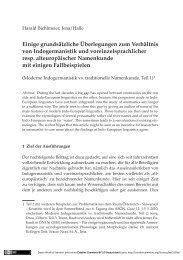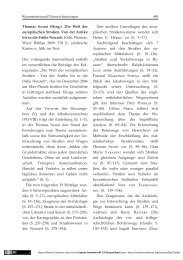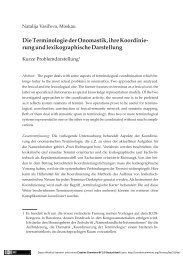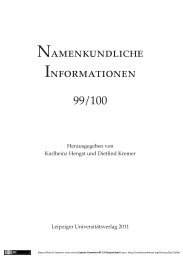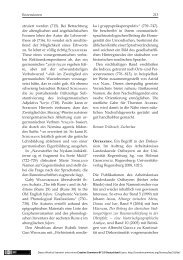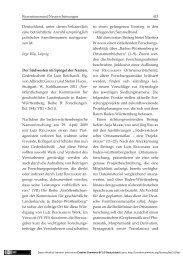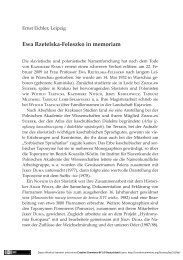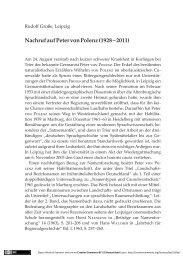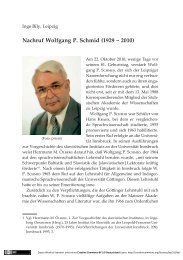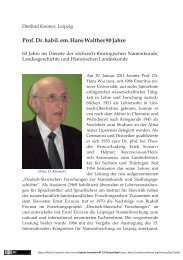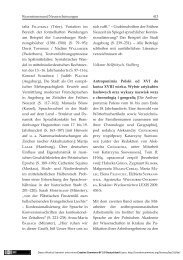Proper Names in the Light of Theoretical Onomastics
Proper Names in the Light of Theoretical Onomastics
Proper Names in the Light of Theoretical Onomastics
Create successful ePaper yourself
Turn your PDF publications into a flip-book with our unique Google optimized e-Paper software.
<strong>Proper</strong> <strong>Names</strong> In <strong>the</strong> <strong>Light</strong> <strong>of</strong> <strong>Theoretical</strong> <strong>Onomastics</strong>129(2) The geographical objects Jánošík’s cave, Farárka and Baračka are located <strong>in</strong> <strong>the</strong> surround<strong>in</strong>gs<strong>of</strong> Trenčianske Teplice.(3) His honour is said to have replied and promised N. money and a knighthood.(D. Krman). – A well-built young man was taken to D., <strong>the</strong> kids were punished and<strong>the</strong> old Gypsy woman was put <strong>in</strong>to prison (W. Scott). – A post-woman <strong>in</strong> N., EmilL., everybody watched <strong>the</strong> m<strong>in</strong>k, which was dragged from a cage by Stanislav Č.(J. Johanides).In context (1) communicant B’s knowledge <strong>of</strong> <strong>the</strong> objects is superficial.However, it is sufficient to identify <strong>the</strong> names <strong>of</strong> Jánošík’s cave, Farárka andBaračka as local geographical names, or more precisely, as geonyms from<strong>the</strong> locality <strong>of</strong> Trenčianske Teplice. In ord<strong>in</strong>ary communication, it is notnecessary to “be familiar with” a generic particularity hence it is sufficientto “know” that e. g. <strong>the</strong> names Jánošík’s cave, Farárka and Baračka are <strong>the</strong>names <strong>of</strong> un<strong>in</strong>habited geographical objects with<strong>in</strong> a set <strong>of</strong> Slovak localarea names.In context (2), however, <strong>the</strong> attention is focused on <strong>the</strong> onymic object.The communicat<strong>in</strong>g person is provided with basic <strong>in</strong>formation on <strong>the</strong>respective onymic objects with which he or she may not necessarily befamiliar. On <strong>the</strong> basis <strong>of</strong> this <strong>in</strong>formation, unambiguous reference identification<strong>of</strong> proper names is possible. In ord<strong>in</strong>ary communication, <strong>the</strong> referenceidentification result<strong>in</strong>g from certa<strong>in</strong> <strong>in</strong>formation and encyclopaedicknowledge is usually emphasized. The knowledge, <strong>in</strong>formation about <strong>the</strong>denotat <strong>of</strong> a proper name, has an <strong>in</strong>dividually variable range, even wherean identical, relatively known object is concerned.(3) The examples quoted, which usually occur <strong>in</strong> written (especiallyartistic) speeches, are specific; a proper name is not referred to <strong>in</strong> its fullform but only <strong>in</strong> its <strong>in</strong>itial (seldom random) letter. Intentionally <strong>in</strong> complete<strong>in</strong>formation is provided by a surname hav<strong>in</strong>g just <strong>the</strong> <strong>in</strong>itial letter <strong>of</strong> <strong>the</strong>surname. In similar cases, <strong>the</strong> provider can talk about <strong>the</strong> onymic objectas such, <strong>the</strong> unambiguous identification <strong>of</strong> this object is not essential to<strong>the</strong> receiver, or should stay a secret, or only pragmatic components <strong>of</strong> <strong>the</strong>name are important. What is significant, however, is <strong>the</strong> circumstance that<strong>the</strong> given context provides <strong>the</strong> <strong>in</strong>formation as to which onymic class <strong>the</strong>object termed <strong>in</strong> <strong>the</strong> abbreviation belongs. Therefore, e. g., <strong>in</strong> <strong>the</strong> statement:Once, it happened <strong>in</strong> <strong>the</strong> town N., <strong>the</strong> abbreviation N. is not just anempty “label” for <strong>the</strong> name <strong>of</strong> an <strong>in</strong>habited place. This form is <strong>the</strong> determ<strong>in</strong><strong>in</strong>gaspect <strong>of</strong> a toponymic sign. The determ<strong>in</strong>ed aspect <strong>of</strong> this signis its proprial semantics (designation). Despite its abbreviated form, <strong>the</strong>



